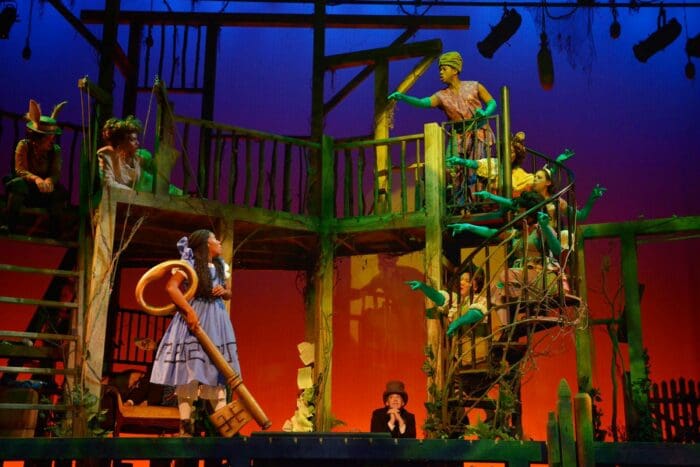
I’m always curious when people choose to adapt a work from another source. I wonder what they’ll choose to highlight from the original work, or what theme they’ll decide to expand upon. I love adaptations for this reason. But even after much thought and reflection, I’m still not sure why Andrew Barbato chose to adapt Lewis Carroll’s famous works, Alice in Wonderland and Through the Looking Glass.
I think that most people are fairly familiar with the Alice in Wonderland story, so I won’t get into too much plot detail. You’ll recognize all your favorite characters in this adaptation, including, of course, Alice, the Mad Hatter, the March Hare, Tweedles Dee and Dum, and the Queen of Hearts. You’ll be introduced to many “new” characters if your Alice experience is limited to the Disney movie.
We first meet Alice on the morning of her birthday, and we are immediately charmed by her. She sings of her birthday wish to have “Another Person’s Life”. Maritza Bostic’s Alice is cheeky, charming, and lovely, and all the things we want in an Alice. Can she sing? You betcha’….this gal could sing the phone book and I’d willingly listen.
Unfortunately for her, some of Barbato and Leslie DeSantis’ music and lyrics were very phone book-esque. There is a lot of repetition in the lyric and the vocal line. A bigger issue was the odd voicing in this piece. Some of it could have been due to the gender-blind casting, like the Frog Footman’s song “Loneliness Calls”. I was miffed that the Frog’s solo, while beautiful, was written in an upper register; the role was otherwise lovingly played by Jenna Lea Scott. Some of the other pieces just seemed difficult to traverse vocally, specifically in the case of Leigh Barrett’s Queen of Hearts’ “Welcome” and “Paint the Roses Red”. When you can hear the break in a voice like Barrett’s, then you might not have the voicing of the character fully pinned down.
Luckily, Barrett’s work in this piece as both Alice’s Mother and The Queen of Hearts is just so strong; the bumpy musicality of her songs falls to the wayside as we watch her breathe life into these women. The moment at the end of the show when Barrett kisses Bostic’s forehead, as Bostic’s Alice gently falls asleep is so filled with tenderness and calm that it’s almost tear-jerking.
I would be remiss not to mention Julia Talbot’s performance as Dinah, Alice’s pet cat, and as the Cheshire Cat in the Wonderland sequences. When I tell you that this young girl’s performance alone is worth seeing the show, I am not exaggerating. Not even a tiny bit. Her physicality as Dinah is nothing short of astonishing, and we think, “Oh wow….that’s amazing. She looks like a real cat on stage.” Then, we are treated to her puppeteering skills as Cheshire Cat, and our minds are completely blown. I have seen adult puppeteers who have worked their entire lives to perfect their craft with less ability than Talbot. I couldn’t wait for her to come back out on the stage!
There are other performances in this show worth mentioning, specifically Jane Bernhard’s March Hare, Elbert Joseph’s Caterpillar and Alexandra Nader’s Cook, although I’m not entirely sure why the Cook is introduced in this work at all. And Aubin Wise as the White Queen is just so wonderful, I had hoped that we were going to explore the relationship between her and Alice on a deeper level, but alas, we did not. Once again I was left wondering why she was introduced at all. There are also some lovely scenes and a musical number, “Sea as Our Guide”, between Mouse, played charmingly by William Gardiner, and Bostic’s Alice, but the continuity of the scenes is destroyed at the end when a large-size Alice makes a return trip on a tiny Mouse’s boat.
Visually, however, the show is extremely strong. The climb-able, crawl-able set by Matthew T. Lazure is so fun and exciting. The spiral staircase allowed Barbato to very creatively stage the Caterpillar. Overall, Barbato’s staging was very creative and used the set in original and exciting ways. Scott Clyve’s lighting design created a lovely atmosphere but I did feel that there were some missed opportunities for specials (a rain effect during “Please Stop Crying” would have been extremely effective), and a lack of specificity between interior and exterior scenes. Sound design by Roger J. Moore was functional albeit uninspired. If there were actual sound enhancements for “Please Stop Crying” and “Sea as Our Guide”, I didn’t hear them and, if there weren’t there, they should have been. The costume design by Lisa Simpson is brilliant, however. While the human costuming is lovely and perfectly period in its own right, Simpson’s ability to balance perfectly the human/animal characteristics in the costumes for Frog Footman, Mouse, March Hare, and Caterpillar was exceptional.
Overall, continuity is a big problem throughout the work. We struggle as an audience to understand where we are and why we are there. With so many additional characters in and out of Alice’s path, the problem is compounded and, while the production remains charming, we leave not quite sure what we were supposed to get out of the story.
